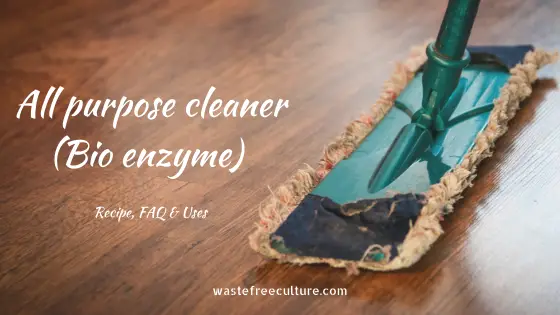Hey, zero waste buddies! Today let’s see an Indian based all-purpose natural cleaner! By using this one ingredient we can clean our entire home. Are you wondering what it is? It is none other than bio enzyme. You might have heard it if not, I’m here to explain.
DISCLOSURE: This post may contain affiliate links, meaning I get a commission if you decide to make a purchase through my links, at no additional cost to you.
Table of Contents
What is Bio enzyme?
Bio enzymes are nothing but the organic compounds which are produced by the fermentation process of the fruits and vegetables in the presence of the brown sugar and water. They are also known as Garbage Enzyme or Fruit Enzyme.
Why Bio enzyme used as an all-purpose cleaner?
The harmful chemicals in the commercial cleaners help to clean our clothes and remove stains from it. But it also affects our health in a harmful way. Let’s look into them in detail to know their harmful effects on our body.
Commonly used chemicals in the commercial cleaners:
Formaldehyde:
Formaldehyde is nothing but a preservative. If you find the terms like formalin, bronopol, urea formaldehyde and phenol formaldehyde, you can say there is a presence of formaldehyde. Keep in mind, it’s not necessary for the manufactures to name all the chemicals used in the product in their label. So, it’s wise to be on the safer side without using the market products.
From air fresheners to shampoos you can see the presence of formaldehyde. It affects your nervous and respiratory systems which lead to throat irritation, chest pain and asthma.
Perchloroethylene:
Perchloroethylene is commonly known as PERC. It can be found in carpet cleaners, dry cleaning agents and spot removers. Inhaling Perchloroethylene causes dizziness, vomiting, lightheadedness and even leads to coma and death when exposed to the larger quantity.
Phthalates:
We’ve already seen the harmful effects of Phthalates in our DIY lip balm recipe. Commonly found in cosmetics and dish soap. It is used for the fragrance so if you cannot find the word Phthalates but you find the word fragrance there is a high chance of phthalates present in the product. It affects the reproductive systems of men by reducing the sperm count.
2-Butoxyethanol:
2-Butoxyethanol is usually found in the multipurpose cleaner and used to provide a pleasant smell to it. It is known to damage the kidney and liver.
Triclosan:
You can find Triclosan in antibacterial soaps and liquid detergents. It may also affect the functions of hormones like endocrine.
How do these chemicals affect our environment?
The harmful chemicals in cleaning products are not only harmful to our health but also to the environment.
Dangerous to plants and animals:
EPA says most of the chemicals found in the cleaners are volatile organic compounds. From this, we can understand that these chemicals not only affect us by contacting our skin while wearing clothes (washed using market cleaners) or using dish wash liquid but also from inhaling them. Due to their volatile nature, they are not only dangerous to humans but also to the plants and animals. Thus, affecting our entire food chain.
Affects our water system:
These chemicals pollute our lakes, rivers and oceans by entering into our water system because in most of the places the wastewater is untreated before heading to these water bodies.
A great example of how the water system gets affected by these chemicals – The lakes form the snowy froth in Bangalore, India due to the chemicals present in the cleaning agents. It does not just affect the water system but also the atmosphere. When the wind blows, the froth gets carried in the air. It creates a bad odour and pollutes the environment very badly.
Plastic packaging:
All the cleaners come in plastic packaging which is hard to recycle and are harmful to our nature and also to the sea animals. Plastics harms the environment not only during its production but also after its usage.
So far, you’ve seen the list of chemicals and its effects in the commercial cleaners. Now it is wise to stay away from all of them by using our own homemade all-purpose cleaner – bio enzyme.
Homemade Bio enzyme recipe:
Few have doubts like do we really need yeast in order to prepare the bio enzyme? The answer is ‘No,’ we can prepare the bio enzyme solution with or without the yeast. Let’s dig into the recipe.
Requirements:
- Jaggery or brown sugar – 1 cup
- Peels of citrus fruits – 3 cups (Orange or Lemon)
- Water – 10 cups
- Yeast – 1 teaspoon (optional)
- Old plastic bottle – 1
You can alter the numbers to increase the quantity but make sure it’s in the ratio 1: 3: 10.
Instructions:
- Cut the jaggery and orange peels into pieces.
- Take an old plastic bottle and fill it with the pieces of jaggery and orange peels.
- Now add the water to it and make sure to leave the gap for the gas which releases during the process. I would say leave 1/4 of the bottle empty. This is really important or else the bottle may tend to burst as there is no space for the released gas from the process.
- Close its lid tightly. The reaction takes place in the anaerobic condition (in the absence of air) you should make sure that the bottle is airtight. Not only that, when it is not closed properly, it attracts worms or insects with its bad smell.
- In the first week, you have to open it once in a day to release the build-up gas from the bottle. Then you’ve to open it in the alternative days in the second week. And for the rest of the days open it once in 3 to 4 days.
- It will take 90 days (3 months) to complete the process for the first time. You can speed up the process from the next time onwards by adding the chunk from the first batch you made into the second batch.
- Keep track of the dates and follow the process as mentioned to get your ideal all-purpose cleaner in 90 days.
- Strain the liquid and use the remaining pulp in your next batch to help the fermentation process to complete within a month or so.
- Store your bio enzyme in the airtight container.
Why are we using these items in the first place?
Jaggery:
The jaggery is also known as the brown sugar will increase the process of fermentation. The reason for using this in a small amount to prevent our bio enzyme from bad odour and insects. Hence try to prepare your bio enzyme with the exact ratio.
Peels of fruits:
The peels of citrus fruits (orange, lemon, sweet lemon etc) are generally used for its cleansing property and smell. But you can also use the peels of other fruits like pomegranate and apple. Sometimes the other fruits may give you the strange smell. Hence choose your fruits wisely.
Personally, I use orange peels because I have orange juices at least twice a week. So, instead of throwing the peels, I use them in Bio Enzyme or in my DIY skincare products. These peels will give a nice scent to our bio enzyme.
Yeast:
Few people use yeast in the mixture to speed up the fermentation process but it’s okay to produce bio enzyme without yeast. The only difference with and without yeast is that by using the yeast in our bio enzyme recipe, we can complete the recipe within 45 days rather than the 90 days.
Plastic bottle:
The reason for not going for the glass or steel containers is that during this fermentation process the carbon dioxide will be released as I mentioned before. So, the glass may crack and the steel container tends to open due to the pressure.
Here we’re not only using the waste but also putting the old plastic containers into good use.
Frequently Asked Questions:
How to know when the bio enzyme is ready?
You’ll find all those peels settled down at the bottom when it’s ready. If it crossed the 90 days and you still find the floating peels, take a sample and give it a try by washing any of your oily utensils. If it cleaned well, then your bio enzyme is ready. Sometimes, all the peels don’t settle down due to various factors hence giving a shot will tell you whether it is ready or not. If it doesn’t clean well, then wait for some days for the peels to settle down and repeat the process.
Things to note:
- Keep it in a dark cool place like under the kitchen sink.
- When the room temperature is high, the jaggery and the peels tend to break faster so the process may take less than 90 days to complete.
- The gas builds up will be reduced so does the quantity level when they completely broke down.
- If you find anything in white colour above the liquid, don’t worry it’s just yeast which is harmless.
Does it smell bad or attract insects?
No, it smells like the fermented fruit but you’ve to make sure that you’ve followed the above-mentioned steps correctly to prevent your bio enzyme from the bad odour.
Similarly, it doesn’t attract any insects or worms if it is closed properly. So make sure to use a plastic bottle with a tight lid.
What to do when I don’t like the smell of the bio enzyme?
Few add rose petals to the solution to get the fragrance of roses. You can do that too. But don’t add the essential oils in the bio enzyme.
Does the bio enzyme kill microbes?
No, the bio enzymes do not kill microbes but eat them up. Yes, you heard me right. There are some good microbes out there which are essential for our life. The good microbes will produce enzymes (during the process) which remove the waste, stain and foul by digesting them. So, our bio enzyme will do the perfect job on cleaning by eating the microbes.
Do I need to store the bio enzyme in the refrigerator?
No, you can simply place them away from the sunlight.
Does bio enzyme expire?
No, you can use them as long as possible. But the problem is you’ll run out of your bio enzyme soon due to its wide range of uses.
Is bio enzyme act as a softener?
It does soften the water and clothes but when compared to commercial ones, they are less effective. Why don’t you try it yourself and share your experience in the comments below?
Uses of bio enzyme:
What can you do with the bio enzyme?
As I told you before it acts as an all-purpose cleaner. You can use bio enzyme to clean from floors, utensils, sinks to toilets.
Washing clothes:
Wash your clothes with a mixture of bio enzyme and soapnut liquid in the ratio of 3: 7. Your clothes will be fresh and super cleaned. Soapnut or Reeta is a foaming agent which helps you to get the natural foam.
Floors:
Take 1 cup of bio enzyme in a bucket full of water and clean your floors as you normally do with the cleaning mop. It will do a great job as that of any floor cleaner will do. If you’re afraid that it may affect the colour of your marble or wooden flooring just replace the bio enzyme with the soapnut solution.
Cleaning fruits and vegetables:
Mix a tablespoon of bio enzyme in a bowl of water. Now wash your fruits and vegetables with this solution by gently rubbing them. Finish washing them again with the tap water. Bio enzyme helps to remove the pesticides from them.
Kitchen cleaner:
Just sprinkle few drops in a cloth or directly on the stove or kitchen counters and wipe them to make them sparkle. Few say it discolours the white marble in such case use the soapnut solution instead of the bio enzyme.
Dish wash liquid:
Add a tablespoon of bio enzyme in a bowl of water and shake it well and use it as a dish wash liquid. You can even clean your utensils with the mixture of bio enzyme and soapnut liquid in the ratio 1: 5.
We all know that we can use soapnut from washing clothes to utensils. Don’t know how to use soapnut as a cleaning agent? Check this article and come back to this post.
Sinks and bathroom floors:
Fill your spray bottle with our homemade bio enzyme and start spraying on the sinks or any affected areas. Then rub firmly using a cloth or coconut husk to remove the salt or any other strains.
Bio enzyme toilet cleaner:
Mix equal quantities of bio enzyme and soap nut liquid. Pour it on the sides of the toilet as you normally do with your toilet cleaner (Eg: Harpic). Rub it with your toilet brush and leave it from 10 to 15 minutes to soak. Then rub the toilet again firmly with your toilet brush. Then finish cleaning with the water.
Pour directly in the drain to de-clog them:
Bio enzymes are not only used for cleaning toilets but also to de-clog our septic tanks or drainage system. We all know that waste will create sludge. So, in order to remove the sludge, the bacteria in the waste will consume them and convert them into the liquid and gas forms either in aerobic or anaerobic condition. This is what usually happens in the drainage or septic tanks.
But for the bacteria, it is quite difficult to digest some of the waste like human excreta. So, when you just pour a little amount of bio enzyme whenever you’re cleaning up the toilet, it’ll speed up the process to decompose the sludge. Not only that the odour will also be reduced and the tanks will function effectively without any clogs. So, it takes a long time to fill up the septic tanks completely.
Bio enzyme for plants:
Bio enzyme is great at nourishing plants by providing strength to protect them from pest and diseases. It also acts as a growth stimulant and thus triggers the plant growth by acting as a catalyst. You can also spray them on the affected plants.
Cleaning water bodies with bio enzyme:
By using microorganisms like yeast, the fermentation process forms mineral salts, organic acids, alcohol, natural chains of proteins and enzymes. A study says that the pH value of the bio-enzyme was found to be 3.5 and when treating the pond water with it, there was a considerable change in COD (Chemical Oxygen Demand), BOD (Biological Oxygen Demand) and DO (Dissolved Oxygen) values of the water. The water bodies were cleaner and lost its bad odour when treated with the bio enzyme.
So, it is proven that the bio enzymes can even purify the water. A study says that 1 litre of bio enzyme can clean up to 1000 litres of water. Isn’t that cool?
What do you think about this zero waste alternative for commercial cleaners? It is cheap, effective and versatile. Do a favour to our Earth by using this zero waste all-purpose cleaner – Bio enzyme.
How do you use bio enzymes in your cleaning routine? Let me hear some new ideas from the comments!
You may also read:
How to use soap nuts for laundry? | 3 different ways
Remove stains from any coloured clothes naturally!
DIY Air Fresheners – Zero Waste & Homemade
Zero waste living | Beginner’s Guide
Zero waste skincare routine for a healthy glowing skin
Zero waste hair care routine – Minimalism
Get rid of dark circles – Natural & Zero waste way!
Homemade Moisturizers for dry skin in winter
DIY Lip Balm: Natural & Zero Waste
Orange peel powder – DIY, Skin & Hair Benefits
Rose petal powder – DIY, Benefits for skin and hair
Zero waste school supplies and tips
Sustainable fashion Guide | Top 9 Ethical clothing brands
Zero waste Christmas – A sustainability guide
Zero waste valentine’s day ideas
10 easy Zero waste swaps you can make today
Composting at home | How to make compost?
Natural mosquito repellents that actually works!
Sustainable Alternatives to Tissues
E-waste: Reuse, Repair, Recycle – towards zero waste
How landfills affect our environment?
What do you do with old plastic? | Zero waste living
Tips to turn waste into something useful at home
11 tips to conserve water at your home
5 Eco-Friendly Food Storage Containers & Cookware
Follow me in social media:




